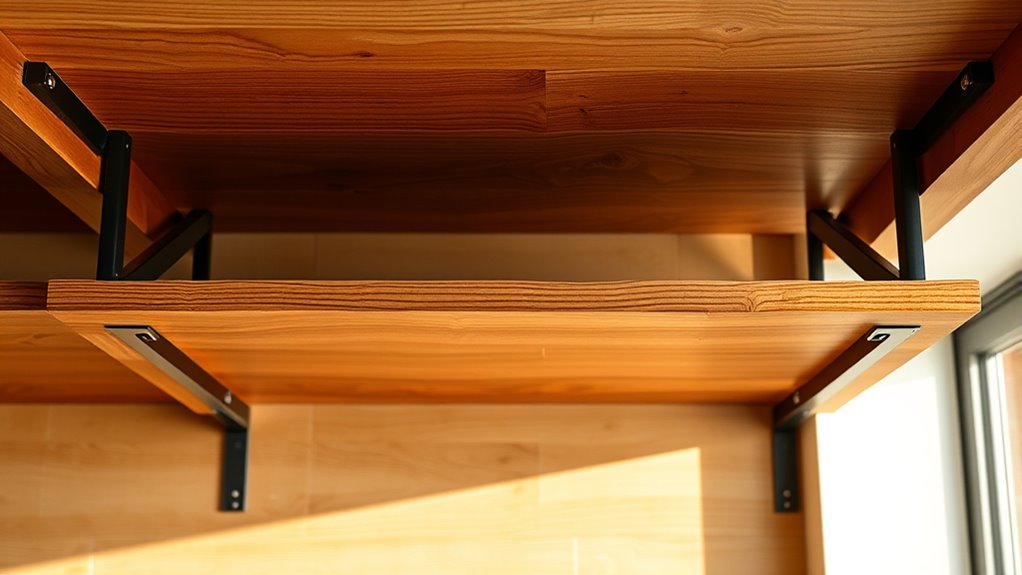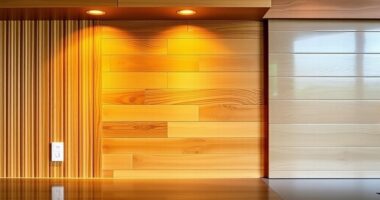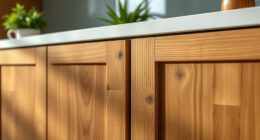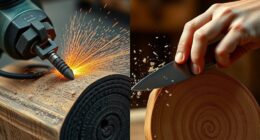To guarantee your open shelving stays sturdy, space brackets every 16 to 24 inches based on your material and weight needs. Use metal brackets for heavy loads and support longer spans with additional brackets or thicker materials. Calculating sag involves understanding load capacity and shelf length; longer spans need more support. Proper placement and support reinforce the structure. Keep exploring to learn how adjusting these factors can help you achieve a stable, attractive shelf that lasts.
Key Takeaways
- Proper bracket placement every 16-24 inches ensures even load distribution and minimizes sagging.
- Selecting brackets based on load capacity and shelf span reduces the risk of warping or failure.
- Calculate sag using formulas that consider bracket strength, shelf length, and weight load for optimal support.
- Reinforcing brackets or choosing heavy-duty options supports heavier items and longer spans.
- Planning for long-term stability involves balancing bracket material, placement, and load limits for safety and durability.
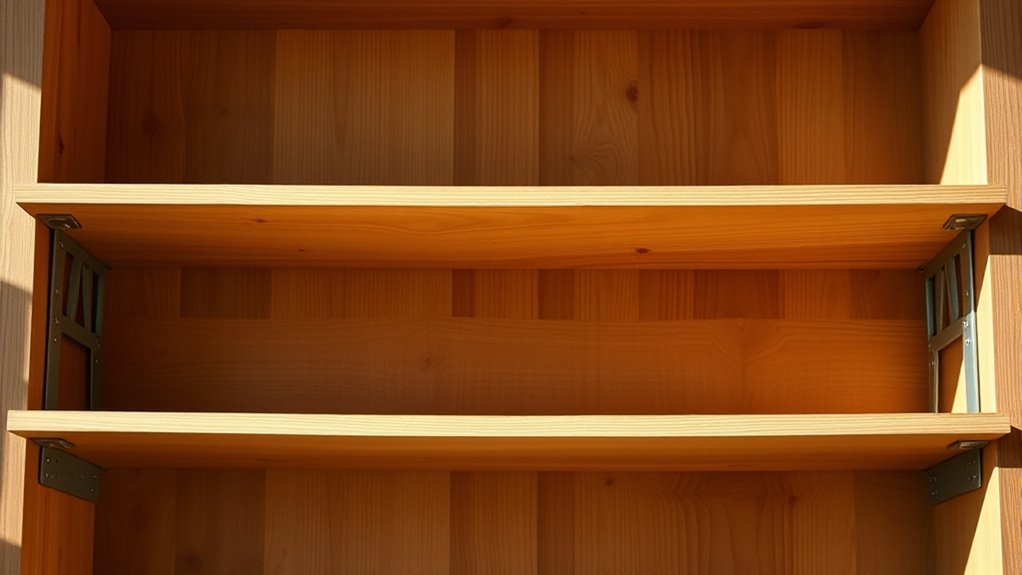
Ever wondered how open shelving can transform your space? It’s an excellent way to add style and functionality, but guaranteeing your shelves stay sturdy requires understanding bracket layouts and sag calculations. The first step is choosing the right bracket material. Metal brackets are popular because they offer strength and durability, especially when supporting heavier loads. Steel, in particular, provides high load capacity and resists bending over time. Wood brackets can add a rustic charm, but they typically aren’t as strong, so they’re best suited for lighter items. Plastic brackets are lightweight and inexpensive but often lack the load-bearing capacity needed for thicker or heavier shelves. When selecting brackets, think about the load distribution. You want to spread weight evenly across the brackets, so your shelves don’t sag or warp. Proper load distribution depends on how many brackets you install and their placement along the length of the shelf. For example, placing brackets too far apart can cause the shelf to bow under weight, especially if the load is concentrated in the middle. To prevent this, aim for brackets every 16 to 24 inches, depending on the shelf material and thickness. If you’re supporting heavier items like books or kitchenware, consider using more brackets or opting for thicker, stronger brackets made from heavy-duty materials. Sag calculations come into play here. You need to determine how much your shelf will sag under certain loads. This involves understanding the load capacity of your brackets and the span of your shelf. A longer span with fewer brackets increases the risk of sagging. To calculate sag, you can use formulas based on the material’s properties and load. For example, a steel bracket supporting a 48-inch shelf with a moderate load might be fine, but if you add extra weight, sag could become noticeable. To minimize this, reinforce the brackets or reduce the span between supports. Additionally, selecting appropriate support brackets designed for your specific load can significantly improve stability. When designing your open shelving, keep in mind that the combination of bracket material, load distribution, and proper sag calculations ensures long-term stability. It’s worth taking the time to plan out your layout carefully, especially if you’re supporting heavy or uneven loads. By selecting the right brackets and placing them thoughtfully, you’ll create a sturdy, attractive shelf that withstands daily use without sagging or failing over time. Remember, the key to successful open shelving isn’t just in how it looks but how well it holds up under the weight you put on it. Proper planning and understanding of load distribution and sag are essential steps toward achieving both style and function in your space.
Frequently Asked Questions
How Do I Choose the Right Brackets for Heavy Loads?
To select the right brackets for heavy loads, you need to take into account shelf weight limits and bracket material compatibility. Opt for sturdy materials like steel or heavy-duty aluminum designed for high weight capacities. Make sure the brackets are rated for the load you plan to put on the shelves. Additionally, choose brackets that match your shelf material and thickness to ensure secure support and prevent sagging or failure.
What Materials Are Best for Open Shelving Brackets?
You should choose brackets made from durable materials like steel or wrought iron, as they support heavy loads and last longer. Decorative brackets add style without sacrificing strength, so look for designs that combine aesthetic appeal with sturdy material. Metal options, especially powder-coated or galvanized steel, resist rust and wear, making them ideal for open shelving. Prioritize durability and visual appeal to guarantee your shelves stay secure and stylish.
How Do Environmental Factors Affect Bracket Longevity?
Environmental factors greatly affect your bracket’s longevity. Moisture damage can cause rust or wood rot, weakening the support over time. Temperature effects, like heat fluctuations, can lead to material expansion or contraction, which may cause brackets to warp or crack. To guarantee durability, choose corrosion-resistant materials like stainless steel or treated wood, and install brackets in areas protected from high humidity or extreme temperature changes.
Can I Install Open Shelves Without Professional Help?
Yes, you can install open shelves yourself if you’re comfortable with DIY projects. Just guarantee you have the right tools, follow instructions carefully, and consider aesthetic aspects like matching brackets and shelf materials to your space. Take your time measuring and marking to keep everything level. Doing it yourself can be rewarding and cost-effective, but don’t hesitate to seek help if you’re unsure about wall types or weight limits.
What Are Common Mistakes in Bracket Placement?
A common mistake in bracket placement is not considering weight distribution, which can cause sag or damage. You might also overlook aesthetic considerations, leading to uneven or unbalanced shelves that clash with your decor. Make sure brackets are aligned with studs or wall anchors for stability. Take time to plan spacing so shelves look balanced and support your items properly, avoiding overloading and ensuring both safety and visual appeal.
Conclusion
By mastering bracket layouts and sag calculations, you’re building a sturdy bridge between your style and safety. Think of your open shelves as a dance, where every support and calculation keeps the rhythm steady, preventing a costly stumble. When you get it right, your shelves become a trusted stage for your treasures—bold yet balanced, a tribute to your craftsmanship. With careful planning, your open shelving will stand tall, telling your story without falter or fall.
